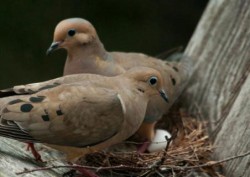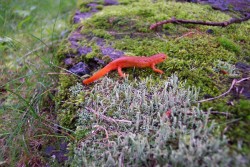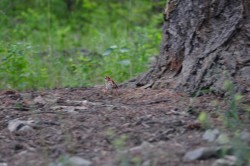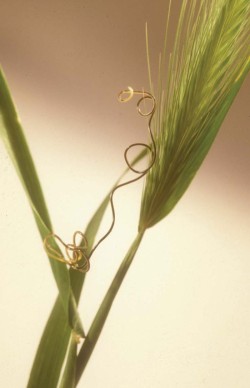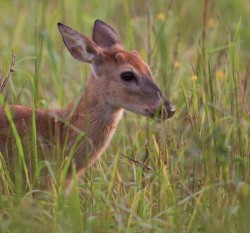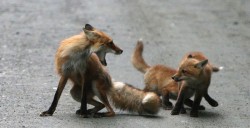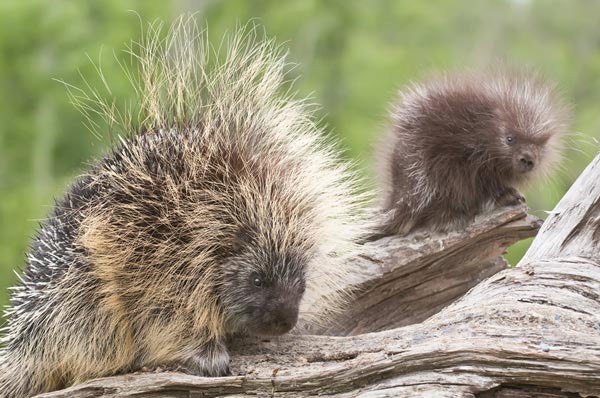
Not long ago, as the ice went out on my local brook, I came across some fresh beaver cuttings and a scent-mound in an area that showed sign of having been dammed before. Did the fresh sign indicate that beavers had moved back into the drainage? Maybe. But maybe not. Fresh sign doesn’t always indicate that an animal has taken up residence; often, it’s left by transients just passing through.
The dispersal of young animals away from where they’re born is called “natal” dispersal, and these youngsters are likely to be transients. Young beavers move in the spring, most songbirds fly from their natal nesting areas in summer, and young deer often wander or are chased off to find new ranges in fall. The timing of the dispersal comes at a tipping point between the ability of the young to be independent and the need of the mother to turn her energies toward the next breeding opportunity. Northern cardinals disperse less than two weeks after hatching, and the parents will raise multiple broods in a single year; male whitetailed deer are self-sufficient and tend to disperse around six months of age; beavers disperse in their third year.
The gender of the animal doing the dispersing also varies. One sex is often the primary disperser, either leaving in greater numbers or traveling farther before settling. Among most mammals, young males disperse and young females stay close to their mothers’ ranges. Coyote packs are typically family groups, with last year’s daughters staying to help mom and dad raise the next litter. When you see does and yearling deer in the fall woods, the yearling is most likely a doe fawn from the previous year; she’ll eventually establish her own range, but it will neighbor and include her mother’s.
The reason that males of most mammal species do the dispersing is that dominant males monopolize access to breeding females. Think big, antler-clashing bucks vying for a ready doe. Biologists call this female defense polygyny, and in such a system, a female’s lifetime reproductive output (i.e., fitness) depends on how well she can exploit her home range to care for herself and her young. Male reproductive output is less about proper care and feeding and more about competing successfully for many mates. In such a system, the females stay put, and the males travel far and wide to find them. Even red-backed salamanders exhibit female defense polygyny and male-biased dispersal, albeit on a scale of centimeters.
Most birds, on the other hand, exhibit female-biased natal dispersal. A male establishes and defends a breeding territory around a nest, enticing females to settle and mate with him in exchange for care and feeding of her and the young. Biologists call this resource-defense breeding, and in this system, the male’s fitness depends upon taking full advantage of a good piece of ground, while the female’s depends on picking a good male.
The mammals that have evolved to feature female-biased dispersal likely did so as a hedge against inbreeding. An alpha male porcupine, for instance, can dominate local breeding for two or more years, leading to the strong possibility of mating with his own daughter – unless she disperses. The mating system is still one of female defense, but the tenure of dominance is long. Contrast this with white-tailed deer, where a male tends to dominate breeding for only a year before being displaced by a stronger and (because of dispersal) unrelated buck. Ultimately, the pattern of dispersal reflects the interplay of access to food and mates with the costs of inbreeding or life as a transient. A slight shift one way or another determines whether the species conforms to the common patterns or becomes an exception.
Despite the evolutionary benefits of dispersal, it is no picnic for individuals. Transients are often too small or inexperienced to compete adequately with residents for food and space. After sometimes violent rejection by their mothers, transients survive in poor habitat unused by others, while under frequent attack by residents. They often suffer death from hunters, cars, malnutrition, and adults of their species. This is why sightings and evidence of mountain lions in New England doesn’t necessarily mean a resident breeding population. (DNA tests on a male mountain lion that was killed by a car in Connecticut in 2011 indicate that it made its way from the Black Hills region of South Dakota.) Dispersers can be pioneers that inhabit (or reinhabit) suitable areas, but a lot of them will die without finding such opportunities.
Yet, in a very real way, the long-term survival of a species depends on these transients seeking new frontiers. Like seed banks and doomsday bunkers, it’s a hedge against disaster. The red efts that are seemingly everywhere in the woods all summer long are the dispersing form of the eastern newt. After hatching in still water, a newt larva metamorphoses into an eft and crawls out of the water. Red efts can cover hundreds of meters in a single summer and can persist in this stage for up to seven years. Many end up back in their natal waters to breed, but if that pond has failed due to silt buildup or dam failure, the newts’ only insurance as a species lies in those lonely migrants – those who made it over the hill and into a new pond, formed behind a dam of shining sticks, recently built by a young beaver who had himself just struck out on his own.


